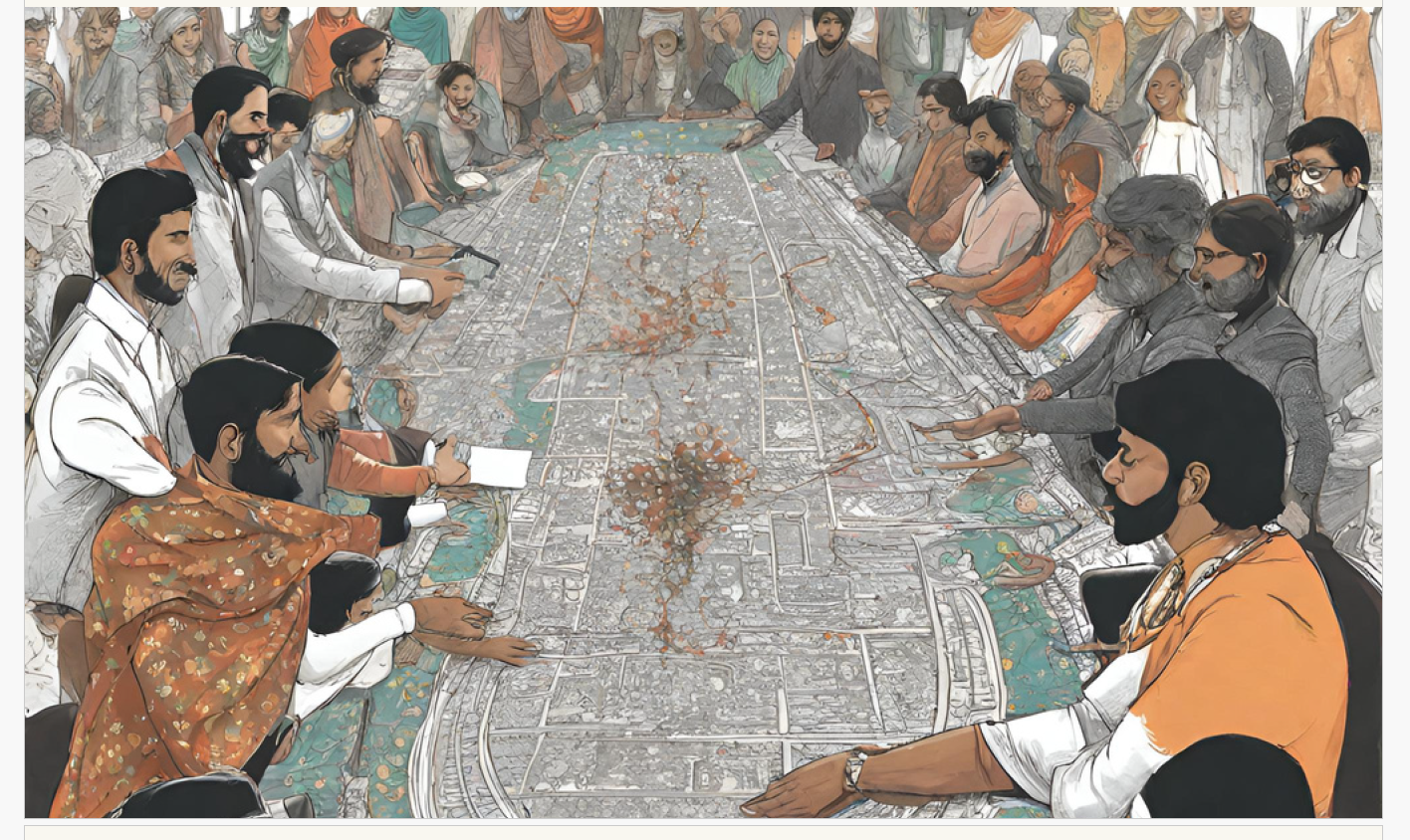Due to their recognition as “soft power” in the context of foreign policy strategy, diasporas have become increasingly influential. Beyond their active engagement in the host nations, they also function as a driver or stimulant of the economic growth of their home countries. Being transnational communities, diasporas are now significant non-state players that influence international politics and economic relations. That being said, the purpose of this paper is to examine the role that the expatriate community has had in Indian foreign policy in recent decades. Owing to the liberalization and globalization of the global financial landscape, as well as the rapid progression of communication and transportation technology that have shortened distances in time and space, the diaspora groups now have much closer socioeconomic, political, and cultural links to their home nations. As a result, overseas communities are now more important than ever not just on the global stage but also in their home nations’ internal political and economic concerns. They eventually were recognized as an “invariable bridge” with significant political and economic ramifications for both their home nation and the host country.
THE SUN NEVER SETS THE INDIAN DIASPORA
The Indian diaspora, which makes up a sizable portion of the worldwide diaspora, is not exempt from the concurrent trends above stated; in the past few years, it has surged to exercise influence over India’s foreign policy and transformed into an indispensable strategic asset. Acknowledging its rightful place on several fronts, India has been making determined attempts to interact with and capitalize on its diaspora, which is thought to number the 25 million and is spread over 136 nations. The High-Level Committee Report on Indian Diaspora, published by the Government of India, accurately notes that “The Sun never sets in the Indian Diaspora,” given its scope and growth.
THE SPORADIC AND PATCHY NEXUS: DIASPORA AND FOREIGN POLICY
Owing to the diaspora’s ingrained engagement in international affairs, it is acknowledged that diaspora policy and foreign policy are convergent. Nonetheless, due to a reckless disposition, the connection between Indian diaspora policy and foreign policy has been inconsistent. Even though British interests were the primary focus of foreign policy during the pre-independence era, the Indian government of the time showed a sincere interest in safeguarding the diverse concerns of Indian expatriates, who were considered “British subjects” despite their residence outside of the British Empire. Through deputations from Congress members, the Indian political elites demonstrated unity and expressed their concerns to the Indian expats. The Indian National Congress spearheaded the independence campaign, and one of its main concerns was the condition of Indians living overseas. The Indian labour migrants sent money home to support their families. One may claim that up to 1947, there was a mutually beneficial relationship between the home country and the diaspora. The notion of diaspora policy underwent a paradigm shift following India’s independence in 1947 since the country’s foreign policy was shaped by Nehruvian principles of non-alignment, respect for sovereignty, and opposition to imperialism and racial apartheid. In terms of the economy, India decided to pursue economic development through self-reliance. Jawaharlal Nehru, who was India’s prime minister at the time, said unequivocally that ethnic Indians who wished to stay overseas would be treated as citizens or nationals of their new countries. They were urged to struggle for the emancipation of their adoptive homeland and assimilate into the host culture. Following a pause, Lal Bahadur Shastri, Nehru’s successor, and Srimavo Bandaranaike resolved the Tamil issue in Sri Lanka. Otherwise, succeeding administrations carried on and expanded the Nehruvian movement until 1980. Subsequently, neither the Indian foreign policy nor the Diaspora policy changed, even though India’s foreign policy under Indira Gandhi switched from Nehruvian idealism to realism. Indeed, she caused herself a great deal of unpopularity between 1968 and 1972 during the East African Indian problem. However, because of the Balance of Payment issue and oil shocks, the government pushed for a remittance-centric strategy, particularly for Gulf Indians. Later, during Rajiv Gandhi’s government, there was a little change in diaspora policy as well, as foreign policy emphasis shifted from realism to inter-third-world cooperation.
In 1986, our relationship with Fiji was strained because of the Fiji-Indian dispute, which he attempted to resolve and provided his friendly support for. In addition, he took administrative actions such as creating the Indian Overseas Affairs Department in 1984 after seeing the potential of the Indian diaspora as a strategic asset. He also welcomed talented Indian diaspora individuals like Sam Pitroda to fulfil his vision of India in the twenty-first century. Until the National Democratic Alliance administration led by the Bharatiya Janata Party took office, there were no proactive measures or definite, consistent policies in place to address or engage with Indians living abroad. Following the end of the Cold War, a multipolar foreign policy emerged, the global economy underwent a structural shift, and the Indian economy faced a persistent foreign reserve crisis in the 1990s. These factors made it easier for the Narasimha Rao-led government of India to announce radical economic reforms like liberalization, privatization, and globalization (LPG). The Indian Diaspora was able to take advantage of the numerous economic prospects presented by the open and unrestricted Indian economy with the introduction of a new economic model. Because of the significant investment and remittances from the Indian diaspora, the foreign exchange issue was overcome. The Indian government then revised its policy toward the diaspora and altered its perspective on it. The BJP-led NDA administration has taken significant action to capitalize on the Indian diaspora. Given this, extensive policy measures, both short- and long term, were announced to engage the country’s diverse diaspora during its tenure. These measures included the appointment of a High-Level Committee on Indian Diaspora, the introduction of the PIO card scheme, the annual Pravasi Bharatiya Divas on January 9th, the presentation of the Pravasi Bharatiya Samman Awards, the provision of Dual citizenship (OCI), and more. A distinct Ministry of Overseas Indian Affairs was formed by the succeeding UPA administration, and it has launched many programs to interact with the diaspora. One may comprehend the reciprocal influence between Indian foreign policy and diaspora policy from the arguments above.
THE RAMIFICATION OF DIASPORA AND FOREIGN POLICY LINKAGES: There have been positive as well as negative consequences for India from the connections between Indian foreign policy and diaspora policy. In hindsight, they were greatly impacted by the Indian freedom movement during the battle for independence. In response to the urgent cry of Indian leaders, they braved foreign territory to free their motherland. Adi Patel, Chhedi Jagan, and Koya were among the Indian expatriates who spearheaded the Indian liberation movement and the political awakening inside their various established nations. India was politically impacted by the beginning of the Gadar movement, the formation of the Azad Hind Fauj and the Komagata Maru tragedy. Mahatma Gandhi, who emerged into a diaspora, was undoubtedly a guiding light in the quest for political independence for India. The Indian Diaspora was not supposed to contribute in any way to India’s political or economic growth after independence, since Nehruvian principles dominated Indian foreign policy. There were political and economic ramifications to this viewpoint. One of them was that India could not intervene when a segment of its diaspora faced extreme hardships, whether economic, social, or political discrimination. for example, in South Africa, Sri Lanka, and Burma. Another disadvantage was that, even though they maintained informal connections with their family back home, they were discouraged from contributing to the economic growth of independent India. After globalization and significant structural changes to the Indian economy, the diaspora in India was later seen as a feasible and probable source of support for the looming foreign exchange crisis of the 1990s. Resuming interactions with the Indian diaspora has significant effects on India’s internal and global political and economic processes. The tremendous lobbying efforts of the Indian community in the US were commendable as they led to the rejection of the Burton Amendment, the breaking of the Indo-US Civil Nuclear Co-operation Agreement, and the defence of India’s nuclear tests in 1998 and the 1999 Kargil conflict. The Indian Caucus on Capitol Hill, along with other advocacy and lobby groups, played a crucial role in advancing India’s national and security objectives on several occasions. India’s diplomatic ties with other nations have been impacted by the substantial presence of a diversified Indian diaspora around the globe. India’s relations with the Gulf countries have long been tainted by the exploitation and mistreatment of Indian labourers there. Remittances decreased as a result of the First Gulf War, which prompted many Indian migrants to escape. It worsened India’s unfavourable balance of payments situation in the 1990s. The recent Libyan Crisis in North Africa and the wars in Iraq and Kuwait have had a rapid impact on our foreign policy toward the area. Furthermore, there were serious worries about India’s diplomatic relations raised by the recent dispute surrounding the evacuation of Indian workers from Saudi Arabia. Deterioration of relationships has also resulted from uneasy interactions between the Indian community and their respective governments.
India’s diplomatic mission in Fiji had to shut down as a result of the coup. Both sides responded negatively to the HINDRAF movement of Indians in Malaysia. There were also some responses from India to the South African radio host’s statements. Following this, the Indian Mission was instructed to maintain a continuous state of alertness between the African and Indian populations. In 2004, a global Sikh movement in support of French Sikhs living in India and the diaspora gave rise to the ban on turban wear among Sikhs in France. France decided in response to pressure from Sikhs throughout the world and the Indian government, particularly under the new leadership of Sikh Prime Minister Manmohan Singh. Reflecting on the domestic political paradigm, it was witnessed that in the US and the UK, the Indian diaspora demonstrated support for anti-emergency groups during the declaration of emergency on the home front. In Punjab, Gujarat, Kerala, and Andhra, they have been financing the state elections. Parliamentarians in these nations were under pressure to take into account the interests and concerns of the Indian people because of their enviable position in the US, UK, and Canada.
DIASPORA IN THE ECONOMIC GROWTH STORY: Remittances and investments from the diaspora supported India’s economic expansion and helped it overcome its foreign reserve issue. In recent times, India has surpassed China in the amount of international remittances received. The Indian diaspora has played a pivotal role in mediating and enabling global commerce and investment due to the prominence of Indian technocrats, entrepreneurs, and management consultants. Certain Indian-American venture investors have provided funding to Indian research and development firms that are expected to generate patents and novel products in the fields of semiconductor design and wireless technologies. The top three in this category are Norwest Venture Group, Kleiner Perkins Caufield & Byers, and West Bridge Capital. As an outcome, they have been actively helping India transition to a knowledge-based economy. To provide healthcare that meets international standards, they have built hospitals such as Apollo, Medicity, and Escorts. Without a doubt, since the Indian economy underwent structural changes, they have evolved into a facilitator of economic progress. Way Forward: Diaspora Diplomacy as a Strategic Asset: It is possible to contend that Indian foreign policy and diaspora policy are simply two sides of the same sword. It is both productive and counterproductive. India has not yet fully capitalized on the Indian Diaspora’s potential in the area of foreign policy. To capitalize on the increasing number of Indians living abroad, a concrete and meticulous policy for the diaspora is essential. India might achieve its long-held goal of becoming a superpower and advance significantly in its international affairs with the adaptable role of the diaspora. Equipped with newly acquired skills and motivated by their civilizational ideals, the twenty million Indian Diaspora has elevated their prominence in the international realm. Despite their diversity— having come from various historical and cultural migratory contexts— they are bound together by their strong emotional and cultural ties to Mother India and their “Indianess.” These are a miniature version of India. To preserve India’s cultural diversity, they do serve as a tactic for “soft power diplomacy.” They have served as advocates, mediators, bridges, lobbyists, and facilitators for giving India’s economic and national security objectives the highest level of priority. Indian academic intellectuals’ experience at US and EU colleges might be useful in raising the bar on higher education. India can increase its human capital by utilizing the youth from its well-exposed diaspora as partners.
BIBLIOGRAPHY
1. Kumar Khara Dr Navin. “Diaspora and Foreign Policy: A Global Perspective.” IJPS 6, no.4, (2020): 12-20. https://www.arcjournals.org/pdfs/ijps/v6-i4/2.pdf
2. Srinivas, Junuguru. “Modi’s Cultural Diplomacy and Role of Indian Diaspora” CEJISS 13, no 2, (2019): 74-90. https://cejiss.org/images/issue_articles/2019-volume 13-issue-2/04-srinivas.pdf
3. Challagalla, Shreya. “The Diaspora and India’s growth story,” ORF, 232, (2018): 1-12. https://www.orfonline.org/research/the-diaspora-and-india-s-growth-story
4. Indian Council of World Affairs. 2001. Report of the High-Level Committee on the Indian Diaspora, New Delhi: ICWA 5. Dr. Mahalingam, “India’s Diaspora Policy and Foreign Policy: An Overview.” GRFDT. https://grfdt.com/PublicationDetails.aspx?Type=Articles&TabId=30
6. Motwani, Jagat K. et al, Global Indian Diaspora: Yesterday, Today and Tomorrow, eds. New York: Global Organization of People of Indian Origin, 2003.
7. Lal, Brij V. The Encyclopedia of the Indian Diaspora, Singapore, Kuala Lumpur, Paris: Editions Didier Millet,2006.
8. The Indian Diaspora and Indian Foreign Policy: Soft Power or Soft Underbelly?” In Diaspora, Devolopment and Democracy: The Domestic Impact of International Migration from India, 185-209. Princeton: Princeton University Press, 2010. https://www.degruyter.com/document/doi/10.1515/9781400835089.185/html?lang=en
9. The Indian Diaspora and Indian Foreign Policy: Soft Power or Soft Underbelly?” In Diaspora, Devolopment and Democracy: The Domestic Impact of International Migration from India, 185-209. Princeton: Princeton University



Leave a Reply